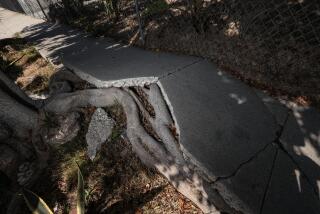Does Mayor Garcetti have a plan for his ‘back to basics’ promise?
- Share via
Eggplant gardens, at least for now, are officially protected in Los Angeles.
Mayor Eric Garcetti told me Tuesday that he has instructed city staff to “cool their jets” after learning from this column about two citizens who’d been ordered to remove vegetable gardens from curbside strips.
Meanwhile, City Council President Herb Wesson introduced a motion Tuesday to “immediately suspend enforcement of Municipal Code Section 56.08(e) in those cases where parkways are being occupied by vegetable gardens....”
Nice work, Herb. But it’s been two years since you promised an ordinance legalizing vegetable gardens on the strips between sidewalk and curb, and this is as far as we’ve gotten?
It’s a reminder that it’s important to keep an eye on this kind of stuff. Any politician can step up to the plate and take a swing, but how’s the follow-through?
Garcetti, for instance, has made clear that he wants to be a “back to basics” mayor, and I like the sound of that. The day he was sworn in, he said his first priorities were to grow the economy, create a more customer-friendly City Hall, and to “fix the potholes and pave the streets, pick up the litter, fix the sidewalks and trim the trees.”
Sounds good. But what’s the plan?
Garcetti told me Tuesday not to expect him to pull off any miracles his first 100 days in office. He estimated the city has 4,500 miles of damaged sidewalk that would cost about $1.5 billion to fix. But he said residents can expect him to put a plan in place that earmarks more money for such repairs and gives priority to the worst hazards.
And where will the money come from?
A number of sources, said Garcetti, possibly including advertising revenue from transit stations, as well as funds from Measure R, the transportation improvement measure voters approved in 2008. But he said the city’s problems are due to “70 years of neglect” and that they “can’t be solved by City Hall itself.” So he intends to have “a brutally honest” conversation with neighborhood groups and businesses about what they want and how to pay for it.
Is that his way of saying he likes the idea of a bond measure, proposed earlier this year by two councilmen, to pay for street repairs?
“If people want to take something to the ballot,” he said, that’s up to them.
In a way, that’s a decision some residents of Mar Vista are already grappling with. As homeowner Chris McKinnon explains it, some neighborhood streets have not been repaved since the 1950s, and curbs and gutters are disintegrating. He said he and his neighbors have spent 13 years trying to get City Hall to do something about it, only to be told, finally, that the city will pave the street if residents pay for new curbs.
Homeowners have been given an estimate of their share of curb repair and asked to vote yes or no on a “curb assessment district” by Aug. 21.
“It’s pitting neighbor against neighbor,” said McKinnon, who would rather not have to pay to have his curb fixed. But he voted yes because he doesn’t see a better option.
His estimated cost, by the way, is $7,500.
“Believe me,” he said, “it is quite a job in convincing neighbors that the curb (and sidewalks and parkway) are owned by the city but we the citizen are liable for their repair and maintenance.”
Neighbors Kerry and Mike Cowden, for example, think they already pay enough in taxes without much of a return.
“We’re voting no, because that’s too much money,” said Kerry, who was also given an estimate of $7,500 for new curbs, even though a private contractor had given an estimate of one-third that price. “They haven’t done anything for us all these years. The streets get cleaned and that’s it.”
She said she got laid off from her teaching job and her husband’s contracting business is struggling, and if the assessment is approved by a simple majority vote, she and everyone else will be assessed the curb fee regardless of how they voted. If that happens, Kerry Cowden said, they may move.
When I asked Garcetti what he thought those residents should do — vote themselves a new tax, or wait for his back-to-basics plan to deliver results — he said he’d leave that up to them. But he said he’s not a fan of the old 50-50 plan, in which residents can apply to split sidewalk repairs with the city. Some people couldn’t afford it, Garcetti said, and it wasn’t a fair use of city resources.
Garcetti, it should be noted, was a working councilman and even council president while services wilted and employee compensation bloomed. But he said he’s focused on what to do now, and if the economy picks up and new revenue is generated, he wants to see it go into city services before “salaries, pensions and healthcare.”
Garcetti, of course, is right about not being able to fix every little sidewalk crack and trim every tree overnight. It’ll take years to even make a dent in the problem. But that’s no excuse for the kind of sloth and mismanagement that allows for abominations like the ruptured sidewalk I wrote about Sunday. For more than a decade, the sidewalk has been a hazard, an embarrassment and a signal that City Hall doesn’t care, even when taxpayers repeatedly request help.
Garcetti told me he had not seen our photo of the sidewalk, which was so ridiculously uplifted by tree roots, I was able to crawl underneath the pavement. So we’ve included another photo today.
If you don’t mind my opinion, Mr. Mayor, I think this one ought to be prioritized.
More to Read
Sign up for Essential California
The most important California stories and recommendations in your inbox every morning.
You may occasionally receive promotional content from the Los Angeles Times.











